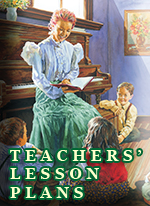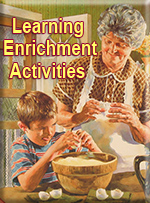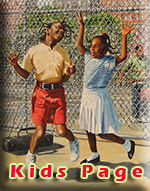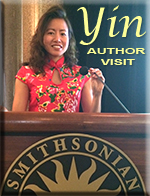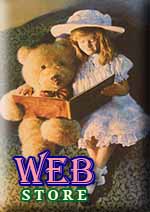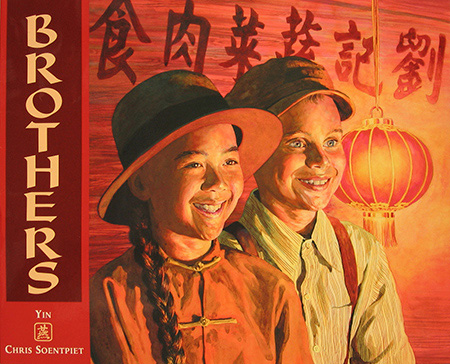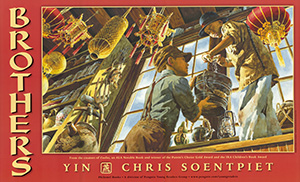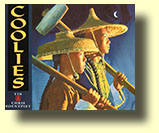|

ABOUT THIS BOOK:
When Ming arrives in San Francisco after the long ocean journey from China, his older brother Shek wastes no time warning him: "Chinese should not go outside Chinatown." Years have passed since Ming's older brothers arrived with the first Chinese railroad workers, but they are still not welcome everywhere.
But then Ming meets Patrick, a young Irish boy with a kind heart. Though the boys come from separate worlds, they learn each other's language and ways. And when Ming's family's store is in danger of closing, their new friendship helps save it, and is a crucial first step toward bringing their two communities together.
Beautifully rendered in richly detailed paintings, this inspiring picture book is the follow-up to Yin and Chris Soentpiet's award-winning Coolies. It is the rarely told story of the first Chinese immigrants and their long road to the American dream, a powerful reminder of what can happen when differences are put aside and friendships are allowed to grow.

MY THOUGHTS ON ILLUSTRATING "BROTHERS":
After the success of COOLIES, Yin and I decided to collaborate again on a sequel. We wanted to introduce the Irish-Americans to this story because they played an important role in immigrant life.

BOOK
REVIEWS:
In this sequel to Coolies (2000), young Ming arrives in San Francisco from China, eager to reconnect with his older brothers. Wong has returned to work on the railroads, but Shek invites Ming to help in his struggling Chinatown grocery store. Life is lonely for Ming until he makes friends with Patrick, an Irish immigrant living in a nearby neighborhood. As the friendship progresses, Ming learns some English, which enables him to promote the store to customers outside of Chinatown, greatly improving business. Soentpiet's luminescent, photo-realistic paintings, which provide many vivid setting details, perfectly complement Yin's thoughtful text. An afterward clarifies that this story is fiction and offers further information about Irish and Chinese immigration in the mid-1800s and the development of San Francisco's Chinatown. Great for group sharing, this tale will be welcomed by classes learning about history, immigration, and multiculturalism, as well as how to be a friend. -(BOOKLIST ,Sally Estes)
Brothers by Yin, illus. by Chris Soentpiet, continues the family story begun with Coolies (PW wrote, "In an impressive debut, Yin illumines a dark corner of American history"), which explored the mistreatment of the thousands of Chinese immigrants who helped build the transcontinental railroad, as Ming joins his older brother Shek. Glorious light-filled illustrations convey the bustle of San Francisco's Chinatown as well as the blossoming friendship between Ming and an Irish peer. Copyright 2006 Reed Business Information. -( Publishers Weekly)
Young Ming, a Chinese immigrant, arrives in San Francisco in the days of the construction of the Transcontinental Railroad. He finds that one of his brothers has gone to work on the railroad, leaving him to work with another brother, Shek, in their grocery in Chinatown. Business is bad, so Shek finds other work, leaving Ming in charge, with a warning that it is dangerous for him, as a Chinese boy, to leave Chinatown. Lonely, Ming wanders out in disguise, making friends with a young boy named Patrick. As the boys spend time together and exchange language lessons, they learn that they have common immigrant experiences. With the help of Patrick and his family, Ming brings business success to the store. The satisfying end finds them "more than friends—…brothers." Soentpiet's watercolors, naturalistic and replete with informative details, create stage sets that occupy three quarters of the double-page spreads; just the merchandise that overcrowds the store demands careful examination. The visual sequences depict the growing friendship with honesty and respect. The street scenes add significantly to the understanding of the times. Notes add additional factual information. -(Children's Literature)
The story of Chinese immigrants living in the US is continued in this sequel to the award-winning picture book Coolies. Ming, the younger brother of Shek, comes to San Francisco to help his brother in their store in Chinatown. When Shek has to leave the store to find more work, Ming gets tired of the days with no customers and decides to chance a visit outside of Chinatown. He is quickly befriended by an Irish boy, and the two of them become fast friends, helping each other with language and getting more business for the store in Chinatown. The book also contains a final page of historical references and resources. Because of their large size and intricate detail, each one of Chris Soentpiet's one-and-a-half page illustrations is a story in itself that is added to by Yin's text. This optimistic story of young immigrants from different cultures working together to create a better life in the US makes this book useful and worthy of attention as an educational resource at many levels.
Text in Children and Young Adult Literature Winner
-(Asian/Pacific American Librarians Association : Honorable Mention for Illustrations in Children Literature 2007)

|
|
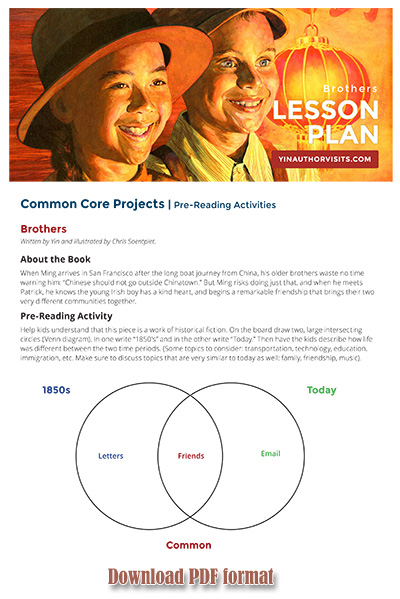 |
Theme: BROTHERS can be used to introduce your students to the history of the Great Potato famine, transcontinental railroad, immigration, foreign language, Chinese-Americans, Irish-Americans and its culture.
Pre-reading: Show the students the cover of the book, read the title, author and illustrator's name. Ask them what they think the book will be about. Have the students look at a globe or world map to locate China, Ireland and the United States.
Reading: As you read and show the illustrations have the students look closely at the drawings. What details can they find in the pictures? Have them look closely at the expressions on the faces for the characters -- how do they change during the story. Ask the students how they think the characters are feeling. Can they tell by the illustrations? Have a US map nearby to find San Francisco. Look for China and Ireland on the world map.
Interview: Discuss the importance of friendships and the many different types – peers, parents and children, etc. Encourage students to share what they have learned.
Math: Ask your students what aid was used before the invention of calculators? Introduce your students to an abacus. They are typically made out of hardwood and beads and can be used to perform addition, subtraction, division and multiplication.
Food: By the 1800s, the potato had become the staple crop in the poorest regions of Ireland. More than three million Irish peasants relied on this vegetable as their source of protein. The Irish often drank a little buttermilk with their meal and used salt, cabbage and fish as seasoning. Did you know the Irish were actually healthier than peasants in England or Europe where bread, far less nutritious, was the staple food? Ask your students what is their staple food at home.
Science: The Chinese practice traditional Chinese medicine. How is this method different from Western medicine? On page 27 of BROTHERS, Shek is using a Chinese scale to weigh herbs-which will be used to treat illness and disease. Explore other method of Chinese medicine such as acupuncture, feng shui and tai chi.
Science: The potato famine killed over a million people in Ireland. Discuss how the weather, illnesses or fungal spores contribute to the failure of the potato crops.
Plant your own potato: If you look at the skin of a potato, you’ll notice brown spots with a little bump in the center. Place your potato in the sunlight for a few days and that little bump will start to sprout seeds.
- Cut a potato into seed pieces, making sure that each piece has one or two seed in it. Let them sit overnight.
- Place 2 inches of soil in the bottom of the pot.
- Spread 3 to 4 seeds in the pot and cover with another 1 inch of soil. Do not completely fill the pot with soil. Water the seeds.
- Once the baby plant begins to grow, put more dirt in the pot and build it up around the sprout's stem. Do not cover the plant. The leaves will appear in about a week. As the plant grows, continue pushing dirt up around the stem.
- Place the pot on a sunny windowsill as soon as possible.
- Water it. Make sure the soil is moist but not soggy.
- In about 8 weeks, the potato will be the size of golf balls. You can eat them once they get to this size or you can wait until it gets bigger.
Social Studies: Where is Ireland on the world map? Make a guidebook to either Ireland or China -- cover topics like cities, geographical features, customs, traditions, folklore, early history, food, games, and traditional dress.
Literature: Read IRISH-AMERICANS-COMING TO AMERICA by Tom Diegnan. Find out what happened to Ming's brothers by reading COOLIES written by Yin. If you really enjoyed BROTHERS write a review and post it on-line at Amazon.com or Barnesandnoble.com so others can enjoy your reading experience.
Art: Chris Soentpiet's realistic paintings depict the use of light and shadow. Have someone model for the class and have your students observe the darkness and the light on the model. Talk about different art techniques. Explore watercolors by mixing primary colors to make secondary colors. Experiment with different brush strokes.
Bulletin Board - As a follow up to the reading, list your students’ nationalities on the board to initiate conversations about America as a melting pot. Then invite students to interview family members to discover those who first came to this country, under what circumstances, their port of entry, etc. Family ties can also be created, shared and displayed. |
|

